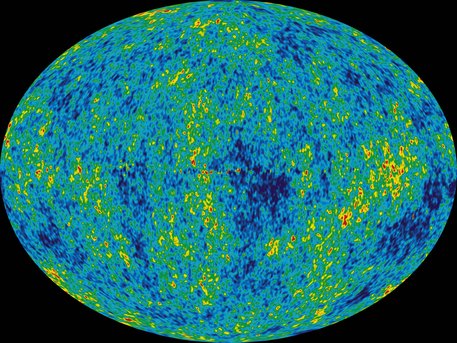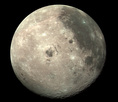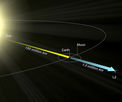The temperature of the Universe
Where is the coldest point in the Universe?
The entire Universe is saturated with what is known as microwave background radiation, a remnant of the Big Bang. The microwave background radiation ensures an even 'space climate'. Microwaves are electromagnetic waves – just like visible light.
 © NASA/WMAP Science Team |
The microwave background radiation is measured coming almost completely uniformly from every direction of space with a temperature of approximately minus 454 degrees Fahrenheit. The different colors show the minimal deviations from this temperature.
However, microwaves have wavelengths between three feet and an eighth of an inch, while the wavelength of light lies between 380 and 780 nanometers.
After the Big Bang, the formation of matter, space and time out of virtually nothing, the prevailing temperatures were at first almost inconceivably high. However, as the Universe expanded the temperature sank – to approximately minus 454 degrees Fahrenheit, the temperature that it is today. The expansion of space also lengthened the wavelength of the electromagnetic radiation until it entered the microwave range of between three feet and an eighth of an inch. Today, this radiation can be measured reaching us evenly from all directions of space – thus the term 'background radiation'. It would 'heat up' any colder object to the space temperature of minus 454 degrees Fahrenheit.
The microwave background radiation ensures an even 'space climate'.
Can the Universe still be colder in some places? Yes, when they are shielded and actively cooled. This is because absolute zero, the lowest temperature theoretically possible, is minus 459.6 degrees Fahrenheit – approximately a further five degrees lower than the temperature in space. This lowest temperature is reached to within a few millionths of a degree in the laboratories of low-temperature physicists, where matter is cooled using complex processes. For this reason, the coldest point in the Universe is on the Earth – providing there is no extra-terrestrial civilization in whose laboratories temperatures are attained that are even closer to absolute zero.
Source: German Aerospace Center
After the Big Bang, the formation of matter, space and time out of virtually nothing, the prevailing temperatures were at first almost inconceivably high. However, as the Universe expanded the temperature sank – to approximately minus 454 degrees Fahrenheit, the temperature that it is today. The expansion of space also lengthened the wavelength of the electromagnetic radiation until it entered the microwave range of between three feet and an eighth of an inch. Today, this radiation can be measured reaching us evenly from all directions of space – thus the term 'background radiation'. It would 'heat up' any colder object to the space temperature of minus 454 degrees Fahrenheit.
The microwave background radiation ensures an even 'space climate'.
Can the Universe still be colder in some places? Yes, when they are shielded and actively cooled. This is because absolute zero, the lowest temperature theoretically possible, is minus 459.6 degrees Fahrenheit – approximately a further five degrees lower than the temperature in space. This lowest temperature is reached to within a few millionths of a degree in the laboratories of low-temperature physicists, where matter is cooled using complex processes. For this reason, the coldest point in the Universe is on the Earth – providing there is no extra-terrestrial civilization in whose laboratories temperatures are attained that are even closer to absolute zero.
Source: German Aerospace Center
The temperature of the Universe
Where is the coldest point in the Universe?
The entire Universe is saturated with what is known as microwave background radiation, a remnant of the Big Bang. The microwave background radiation ensures an even 'space climate'. Microwaves are electromagnetic waves – just like visible light.
 © NASA/WMAP Science Team |
The microwave background radiation is measured coming almost completely uniformly from every direction of space with a temperature of approximately minus 454 degrees Fahrenheit. The different colors show the minimal deviations from this temperature.
However, microwaves have wavelengths between three feet and an eighth of an inch, while the wavelength of light lies between 380 and 780 nanometers.
After the Big Bang, the formation of matter, space and time out of virtually nothing, the prevailing temperatures were at first almost inconceivably high. However, as the Universe expanded the temperature sank – to approximately minus 454 degrees Fahrenheit, the temperature that it is today. The expansion of space also lengthened the wavelength of the electromagnetic radiation until it entered the microwave range of between three feet and an eighth of an inch. Today, this radiation can be measured reaching us evenly from all directions of space – thus the term 'background radiation'. It would 'heat up' any colder object to the space temperature of minus 454 degrees Fahrenheit.
The microwave background radiation ensures an even 'space climate'.
Can the Universe still be colder in some places? Yes, when they are shielded and actively cooled. This is because absolute zero, the lowest temperature theoretically possible, is minus 459.6 degrees Fahrenheit – approximately a further five degrees lower than the temperature in space. This lowest temperature is reached to within a few millionths of a degree in the laboratories of low-temperature physicists, where matter is cooled using complex processes. For this reason, the coldest point in the Universe is on the Earth – providing there is no extra-terrestrial civilization in whose laboratories temperatures are attained that are even closer to absolute zero.
Source: German Aerospace Center
After the Big Bang, the formation of matter, space and time out of virtually nothing, the prevailing temperatures were at first almost inconceivably high. However, as the Universe expanded the temperature sank – to approximately minus 454 degrees Fahrenheit, the temperature that it is today. The expansion of space also lengthened the wavelength of the electromagnetic radiation until it entered the microwave range of between three feet and an eighth of an inch. Today, this radiation can be measured reaching us evenly from all directions of space – thus the term 'background radiation'. It would 'heat up' any colder object to the space temperature of minus 454 degrees Fahrenheit.
The microwave background radiation ensures an even 'space climate'.
Can the Universe still be colder in some places? Yes, when they are shielded and actively cooled. This is because absolute zero, the lowest temperature theoretically possible, is minus 459.6 degrees Fahrenheit – approximately a further five degrees lower than the temperature in space. This lowest temperature is reached to within a few millionths of a degree in the laboratories of low-temperature physicists, where matter is cooled using complex processes. For this reason, the coldest point in the Universe is on the Earth – providing there is no extra-terrestrial civilization in whose laboratories temperatures are attained that are even closer to absolute zero.
Source: German Aerospace Center










